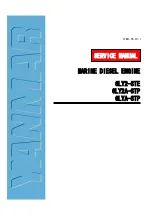
RDG603A13
– Issue 19
Page 44 of 97
Siphon Breaker Fitting Instructions
1. The unit must be positioned upright, well above waterline. The height above
waterline will vary from vessel to vessel but will be between 150mm and 2
metres. Please seek guidance on this if you are unsure, or if you are not familiar
with the correct way to incorporate a siphon breaker into your particular exhaust
system.
2.
The inverted “U” bend at the top must be connected to a hose draining into the
bilge, or over the side of the vessel. In no circumstances must this drain into a
sealed container, such as a bottle due to the risk of back siphoning. After fitting,
run the engine and check the unions for leaks. Check again after 5 running hours.
3. The siphon break is equally suitable for use with a marine toilet water inlet.
4.
The ½” unit may also be used with 5/8” systems. The 3/4” and 1” units may only
be used with the correct hose.
Siphon Breaker Maintenance
1. On commercial vessels achieving in excess of 150 engine hours per year, the
unit should have the small valve removed from the top and this should be
thoroughly washed in warm soapy water to remove salt encrustation.
2. On a pleasure vessel this should be done twice a year.
3. On reassembly the engine should be run and the unit checked for leaks. The
hose junctions should also be checked for leaks as part of the daily inspection
procedure for sea cocks, water pipes, oil levels, etc.
22. Hydraulic Drive Transmissions
If an engine is to have a hydraulic drive transmission attached to it instead of a conventional
marine gearbox, a number of points must be observed.
Bobtail engines (i.e. Engines supplied without a marine gearbox), normally do not have a
gearbox oil cooler fitted. However if a cooler is supplied, this will only be suitable to cools
a conventional marine gearbox.
Hydraulic drive transmissions generate far more heat than a conventional marine
gearbox. Therefore the size of the oil cooler installed must be calculated by the hydraulic
drive transmission supplier. This is to ensure it has sufficient cooling capacity and is sized
appropriately taking into account:
Maximum engine power.
High ambient summer air temperature.
Summer River/Canal/Sea temperature.
















































